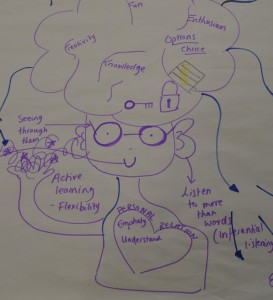It’s long been my belief that, given the right framework, students can create the natural conditions for powerful learning to take place. My problem has always been finding the right framework. Today, I think I found it. Matthew Moss High School in Rochdale, England has been on a 20-year journey to create what I’ve called ‘school as learning commons’. In the 5 years that I’ve followed their progress, I’ve seen them democratise schooling through a series of measures which have both de-privatised the secret business of teaching, and given learners the tools they need to work it out for themselves. I’ve seen Year 7/8 students introduced to Transactional Analysis, Carol Dweck’s Mindset and Neuro – Linguistic Programming. I’ve seen them adopt Project-Based Learning so that their curriculum can have more relevance and authenticity.
Their latest innovation, however, is perhaps their boldest, and most exciting. Eight weeks ago, they brought together senior students with ‘learning coaches’ recruited from the local community college. The coaches aren’t much more than a year older than the students they’re working with. They had a grand total of four hours training, and were thrown in at the deep end. It should have been a disaster. Instead, I think it could point to a revolutionary – and highly efficient – model of learning.

As the video below explains, D6 (don’t call it a Saturday school) arose out of a critical OFSTED inspection. Headteacher Mark Moorhouse’s response could easily have been to dismiss the inspectors as not understanding what they were trying to do. Instead they have created a brilliant way to improve their student’s academic performance through allowing them to determine their own learning. ‘D6’ puts learners in charge, but supports them through employing the young learning coaches. Note, these students are paid to be learning coaches. The relationship is different to that of a teacher-student: not better, just different.
Last week’s blog identified the key features of D6. This week, I want to focus on the coaches’ learning. I spent an hour with them reviewing their involvement so far, and the most striking aspect of this experiment is that, left almost entirely to their own devices, students and coaches have instinctively arrived at a model of learning which combines 5 of the features of great learning we’ve long known about, but rarely witness in most schools:
1. Study groups – students have, almost haphazardly, formed small groups (4-6 students) to collaborate over their learning;
2. Adopted multi-modal ways of teaching – Through a ‘I used to think/Now I think’ exercise, I asked coaches to reflect on how their views on what makes effective learning had changed since working on D6. The most common shifts were: from individual to group; from text to talk; from lecture to conversation; from making notes to active learning. (No-one trained them to make this realisation -astonishingly, it’s occurred in less than eight weeks, simply through getting to know their students);
3. Horizontal relevance – initially coaches prepared ‘lessons’ for their students. They soon realised, however, that this approach was only ‘vertically relevant’ – giving them information in the hope that it might be useful at some point in the future. Having students ask them questions to solve the problems they were grappling with now was ‘horizontally relevant’ and more likely to stick (student grades are already rising sharply);
4. Student-driven didactic learning – Seymour Sarason used to say that a great teacher wasn’t the one asking all the questions – she was the one on the receiving end of all the questions. A lot of the coaches were didactically explaining things at whiteboards – the difference here was that they were prompted to do so by student’s questions, and students were up there with them, working problems out. Too often, our default position is to do the explanation without the invitation;
5. Relationships matter more than subject expertise – the coaches weren’t able to pretend they had all the answers, so didn’t even try. But already there are strong bonds forming and, by fluidly spreading themselves around study groups, they are giving students multi-perspectives, and letting them work out what works best for them.
D6 is a remarkable innovation. If self-determined learning was to scale, it would have profound consequences for the way we organise schooling. In the last post, I asked if a ‘not-school’ model could be brought back into school, but perhaps that’s not the point. As the three students in the video point out, being able to drive one’s own learning doesn’t replace good teaching – it accompanies it.




It’s encouraging to see how much can be achieved with a coherent whole-school approach to placing learners at the heart of the process while stretching them and not limiting them to what they already know. We have experimented with study circles with some success at my college but haven’t scaled up yet. I think this is an useful and welcome contribution to the often polarised debate about learner-centredness versus didacticism.
This is remarkable. Congratulations to the school, the coaches and the students.
Would love to have observed these coaches in action. What takes up a lot of my thinking time is that we have ample evidence like this that we need to rethink mainstream education. People know how to learn. What we need to do is let them learn and get out of the way.